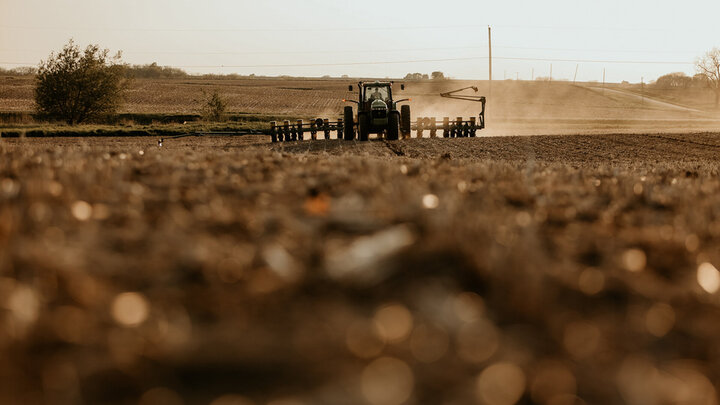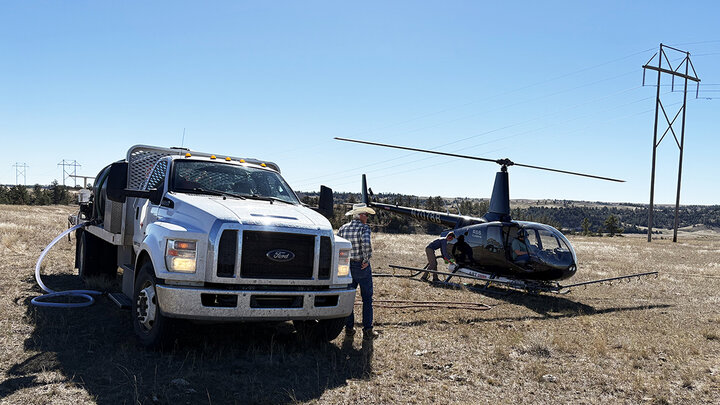By Dylan Mangel - Extension Plant Pathologist, Asha Mane - Graduate Student, Sydney Everhart - Associate Professor of Plant Pathology, Tamra Jackson-Ziems - Extension Plant Pathologist
Pathogen
Frogeye leaf spot (FLS), caused by the fungus Cercospora sojina, has become a disease of growing importance in Nebraska (Figure 1). While yield loss to the disease is often minor, when conditions are optimal, it may hasten maturity by causing premature defoliation. Yield loss estimates due to frogeye leaf spot have been reported as high as 30% with extensive leaf blighting. In Nebraska, highly susceptible varieties could experience yield losses of up to 20%.

This pathogen survives on the residue of previous soybean crops, so the disease is most severe when soybean is grown continuously in the same field, and in situations where tillage is reduced. While most primary infections start from infected residue, infected seed can also carry the pathogen (Figure 2), and airborne spores will blow from field to field during the growing season.
Video: Frogeye leaf spot identification and management
Disease Symptoms
Infection can occur at any stage of soybean development but most often occurs after flowering and is typically in the upper canopy. Initial symptoms are small, dark spots on the leaves. Spots eventually enlarge to a diameter of about ¼ inch, and the centers of the lesions become gray to brown and have a reddish-purple margin. Individual leaf spots can coalesce to create irregular blighting patterns on the leaf.

In addition, stems and pods can also be affected. Stem infections appear later in the season and will be long, narrow dark lesions with flattened centers. Pod lesions will be circular to elongated, slightly sunken and reddish-brown. As with the foliar lesions, the centers of these lesions will become gray to brown as they mature. Severe pod infection can result in infected and discolored seed. Seed symptoms will appear as gray and brown specks or blotches on the seed coat. Infected seed can have cracked and flaking seed coats.
Favorable Environmental Conditions
Infection occurs more readily in young leaves than older mature leaves. This is why the disease is observed mostly in the upper canopy when it occurs later in the season. This change in susceptibility of the leaves as they develop can result in the layered occurrence of the disease in the plant canopy. Frogeye leaf spot development is favored by warm, moist weather, which promotes sporulation of the pathogen in the primary lesions. Conidia are dispersed by wind or splashing rain.
Management of Frogeye Leaf Spot
Genetic Resistance
Soybean varieties vary in their resistance to Frogeye Leaf Spot and there are several genes commonly used for resistance. Resistance gene Rcs3 has been reported to be resistant against all known races of the FLS pathogen in the United States. Growers should consult with seed company representatives and review disease ratings to identify resistant varieties.
Cultural Practices
Frogeye leaf spot is more severe in continuously cropped soybean fields. Reduced tillage systems will tend to have more as the pathogen overwinters in the residue. Rotating to non-host crops like corn will allow time for residue and inoculum degradation.
Chemical/Biological Control
Appropriate fungicide applications can effectively control frogeye leaf spot. Products applied to soybean at reproductive stages R3 (beginning pod) to R5 (beginning seed) are most effective. Group 11 Quinone Outside Inhibitor (QoI) fungicides (formerly referred to as “strobilurin”) were historically the most widely used for management of frogeye leaf spot. However, resistance to this class of fungicides was documented in numerous U.S. states since 2010, and in Nebraska in 2019. Extensive surveys across our state have since identified that the resistance is widespread (Figure 3). This means that Group 11 fungicides are no longer as effective as they once were.

If a fungicide application is necessary to control frogeye leaf spot, avoid spraying products that contain only Group 11 (QoI) active ingredients. Products with two or more effective active ingredients, like FRAC groups 3 (DMI/Triazoles) or 7 (SDHI/Carboxamides) with mixed modes of action (from multiple FRAC fungicide classes) will be more likely to provide effective control of the disease. Relative efficacy of fungicides on FLS can be found in the Crop Protection Network’s publication on Fungicide Efficacy for Control of Soybean Foliar Diseases.
Additional Resources
- Fungicide Efficacy for Control of Soybean Foliar Diseases (Crop Protection Network)
- Frogeye Leaf Spot (publication CPH-1017), and Frogeye Leaf Spot of Soybean, published by the Crop Protection Network
Information for this page was originally produced by Loren Giesler and updated by Dylan Mangel.
Soybean Diseases
- Soybean Diseases (Home)
- Anthracnose
- Bacterial Blight
- Bacterial Pustule
- Bean Pod Mottle Virus
- Brown Spot
- Brown Stem Rot
- Charcoal Rot
- Frogeye Leaf Spot
- Phytophthora Root and Stem Rot
- Pod and Stem Blight
- Purple Seed Stain
- Rhizoctonia Root Rot
- Sclerotinia Stem Rot
- Soybean Cyst Nematode (SCN)
- Soybean Mosaic Virus
- Soybean Rust
- Stem Canker
- Sudden Death Syndrome (SDS)








